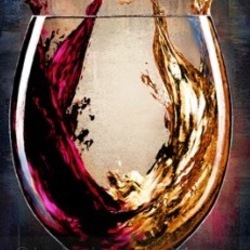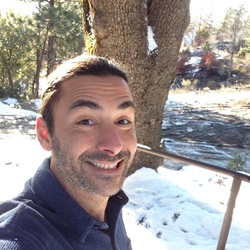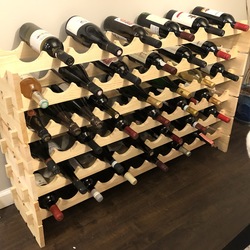Aujoux Négociant
Château Canon
Saint-Émilion Red Bordeaux Blend 1986
We were suppose to be in Napa this weekend. Sadly, no one should be in Napa/Sonoma except Firefighters and first responders. However in lieu of; the Sodhani party, appointments at Beau Vinge, Mark Herold & a steak at Cole’s Chop House, what the next best thing? #STEAKANDCLARETNIGHT at home in the backyard. This 86 was amazing with my ribeye. The kind of pleasure that causes great pause and rolls the eyes a bit. On the nose; menthol, eucalyptus, dry herbs, soft ripe blackberries, dark cherries, strawberries, baked plum, perfectly stated baking spices, stones, soft unstated spice, clay, rich dark earth, touch of black cherry cola and fresh & dark florals. The palate is heaven as it coats. The body medium full, layered and the tannins are nicely resolved but not completely...still a fair amount of life in this bottle. I’d say it’s still around it’s peak. The fruits are ripe and still fresh. Blackberries, baked plum, dark cherries, strawberries, dry cranberries, hues of blueberries, black cherry cola, sweet darker spice, vanilla, clove, nutmeg, cinnamon, dark rich earth, dry stones, tobacco, suede leather, dry clay, menthol, eucalyptus, touch of dry herbs, fresh & dry dark flowers, beautiful, round acidity, perfect 12.5% alcohol and a long, even, elegantly balanced with beautiful structure, tension & length that’s lasts two minutes. It’s in a really excellent spot. 9.6 with the ribeye and 9.4 on it’s own. Photos of; an aerial shot of Chateau Canon, owners Alain and Gerard Wertheimer who made their first big money on Chanel, own Rauzan-Segla and are worth just under a paltry 10 billion, their barrel room and their Saint-Emilion vineyard. Producer notes and history...Chateau Canon is a premier cru with a history of fine vintages. This Saint-Emilion property has long been recognised as one of the best in the appellation. It is believed that Canon was named after Jacques Kanon, the naval officer who bought estate in 1760. He built the château here and surrounded it with plantings solely of vines...a rare agricultural practice at the time. However, he then sold the estate to a Bordeaux négociant just ten years later. In 1919 it was purchased by the Fournier family, who owned the property until 1996. When they sold it to the Wertheimer family, owners of Chanel and of Rauzan-Ségla in Margaux it unfortunately had some serious problems. The cellars were contaminated with TCA, the chemical compound which causes cork taint. Many of the vines were infected by viruses and in need of being replaced. As well, part of the vineyard above the quarried cellars had subsided. Fortunately the Wertheimers had the money to fix these issues and a manager, John Kolasa with the skills. The first decade of the 21st century saw Canon begin to regain its reputation once John Kolasa retired and Nicolas Audebert at Rauzan-Ségla took over. The substantial estate covers 22 hectares on Saint-Emilion’s famous limestone plateau close to the town. The vines have an average age of 25 years and are generally planted with a southerly or south-westerly exposure. 75% of the vines are Merlot and 25% Cabernet Franc. After the grapes are hand-picked, they are fermented in traditional cone-shaped vats, before spending 18 months ageing in oak barrels, 50% new and 50% used. — 8 years ago


North Park Urban Winery
Négociant Borden Ranch Barbera 2014
Tasty new world barbera — 9 years ago
Domaine Leroy
Les Cazetiers Gevrey-Chambertin 1er Cru Pinot Noir 1949
Vintage 1949 in Burgundy according to Broadbent: “..most perfect end of a decade - elegant, well-balanced wines”; Clive Coates in his book Cote D'Or: "best vintage of 40's all-perfect beauty and purity”; Robert M. Parker Jr.: “it was the best of post world war II vintages before 1959”
Henri Leroy at that time was négociant based in Auxey-Duresses, his mythical daughter Lalou Bize-Leroy in 1949 was only seventeen.
Les Cazetiers is amongst the most elevated of Premier Cru site in Gevrey-Chambertin - and indeed the whole of Burgundy.
I drank this precious bottle on Mount Etna with #FrankCornelissen and other dear friends. Uncork this bottle lead to a surgical operation. Just begun to pull it out, a light breath of wine molecule with air bubbles magically have emerged on the surface of the cork. It's been like witness the passing away of a dying old man (or Pinot Noir must be a woman?) That humanized wine had held "élan vital", hope and breath inside him for the last 66 years! A miracle of a wine still so tasty, robust, citrusy, vibrant, earthy, incredibly alive and well-preserved despite color and neck level did not bode so well.. that's what I thought and I'll remember until I die: "the wine was waiting for us to drink it up, he gave off his mortal blow to offer us life, joy and smile!" — 10 years ago
Domaine Leroy
Bourgogne Chardonnay 1999
Actually 'just' a Maison (négociant) wine from Leroy but this was in spectacular shape. Drunk blind on Friday arvo options, had me fooled as I thought it half the age village at least. Deep, rich lemon in colour, looked viscous and clingy as it rolled around the glass. On the nose: smoky, honey, creamy, nutty and with fresh stone fruit and lemon, that fruit more obvious with 15 minutes plus open. On the palate, no more than medium bodied, rich but nothing sluggish or flabby here; alert acidity, a touch of honeydew melon and nut up front but firmer fruits through the middle, that creamy/nutty taste and texture wrapping the fruit tight. Touch of oak caressing the gums as the fruit rolls through to a long finish. Delicious drinking - such an impression of effortless intensity and freshness. — 11 years ago
Domaine Henri Boillot
Clos de la Mouchère Monopole Puligny-Montrachet 1er Cru Chardonnay 2013
One the nose, a touch of sour green apple, lime zest, ripe pineapple, mango, lemon, touch of mint, stone fruit skin, honey, green melon, limestone minerals, sea shells, yellow lilies & spring flowers.
The palate is thick and rich from a touch extra lees stirring. A touch of sour green apple, lime zest, ripe pineapple, mango, lemon, touch of mint, stone fruit skin, honey green melon, limestone minerals, sea shells, yellow lilies & spring flowers. Good round acidity with a long rich finish that lasts minutes.
Photos; Puligny-Montrachet -Clos de la Mouchere, owner/Winemaker Henri Boillot and their Domaine.
Producer notes & history... Before striking out on his own in 1984 Henri had worked for the family firm but his success in his own right persuaded his grandfather Jean Boillot to persuade him to return to the fold. In 2005 Henri bought out his brother and sister and renamed the domaine name from Domaine Jean Boillot to Domaine Henri Boillot to avoid confusion with his brother Jean-Marc Boillot's company.
The Domaine consists of some 19 hectares, mostly in Puligny and Meursault for white wines where he owns the monopole of Clos de la Mouchere, and in Savigny-les-Beaunes, Beaune and Volnay for reds.
In the vineyard Henri and Guillaume farm sustainably, avoiding artificial pesticides and herbicides, and much hard work in the vineyard means low yields of relatively late-picked fruit at a peak of ripeness. The whites are very gently crushed to avoid bitter flavours and fermented in barrels larger than the norm at 350 litres so that the purity and freshness of the fruit is unencumbered, and bottling follows 18 months or so in barrel. Pinot noir grapes are sorted in the vineyard before being taken to the winery, destemmed, crushed and cold soaked before a fairly long fermentation. 18 months in barriques is the norm before being bottle unfined and unfiltered.
Since 2006, he has worked with his son Guillaume, who now makes the red wines, at their new state-of-the-art winery in Meursault where all the Domaine and 'négociant' wines (under the label of Maison Henri Boillot) are made. — 8 years ago
Domaine Leroy
Bourgogne Pinot Noir 2015
On the nose, nicely concentrated wild dark berries, black plum, notes of blue fruits, vanilla, understated cinnamon, soft, warm spices, Christmas cake and fresh dark, fragrant florals. The mouthfeel is rich & concentrated. The fruits dark are clearly fresh & ripe. Wild dark berries, black plum, plum, dark cherries, poached strawberries, black raspberries, Thompson raisins, light vanilla, soft warm spices, limestone minerals, grainy/silky chalkiness, dark moist soils, crushed rocks, violets, fresh dark florals, touch of mint, beautiful round acidity and amazing long rich beautiful finish that is well balanced fruit & earth. This is a vintage (even though Bourgogne) will cellar around 20 years. My rating could jump 2-3 points with proper storage years in the cellar. It's tasting more like 1st Cru than village wine. Photo tour of the estate, open top fermenters (I believe they ferment all their lots separately) and Lalou Bize-Leroy singing and talking to her precious vines. Producer history and notes...Domaine Leroy is arguably producing the greatest red Burgundy wines in the Cote d`Or at present. Lalou Bize-Leroy started out as a négociant, working for her family's Maison Leroy, which was founded by her father Henri. There are three parts to the Leroy empire; the Maison Leroy based in Auxey-Duresses, Domaine d’Auvenay and substantial holdings in Vosne-Romanée. Lalou Bize-Leroy also owns 25% of Domaine de la Romanée-Conti, where she was co-director until the other shareholders ousted her in 1992, partly because she had started a competing winery. Domaine Leroy has been farmed biodynamically from the start and is now certified by ECOCERT. The other exciting, if not controversial, move was the change in training system for the vines. For some time previously the hedging (rognage) of the vineyards had been done by hand rather than more abrasively by machine. However, it is not natural for the vine to be cut back as it affects the vine’s performance both in the current season and the following year. So now, after the flowering, when the shoots are lengthening, they are curled over instead of being cut back. This minimises entrecoeurs and second crop bunches forming, as well as leaving the vine happier and healthier. She also talks and sings to her vines daily. She believes this promotes health of the vines and who could argue with her given what she puts in the bottle. Lalou Bize-Leroy has 23 hectares of vines, mostly Premier and Grand Cru classified. In the vineyard, Lalou practices biodynamism as well as severe pruning and crop-thinning. The result is ridiculously low yields. Yield arguments at DRC were also an issue in her departure. You want to buy this wine. $39.99 at K&L Wine Merchants on pre-arrival. Just bought four bottles.
— 8 years ago
D'ici
Côtes de Provence Rosé Blend 2013
Exclusive sélection made by a Bordeaux Négociant. Great Provence — 11 years ago
Matthiasson
Quake Cuvée Napa Valley Cabernet Sauvignon
Pre-order MATTHIASSON Quake Cuvée, a Napa Red négociant blend to be created by Steve Matthiasson to assist the community as soon as possible. All after-tax profits will benefit the NAPA VALLEY COMMUNITY DISASTER RELIEF FUND and their efforts to provide immediate financial support and resources for those most in need.
Please note: This wine will ship in the Spring 2015!
— 11 years ago
Hospices de Beaune
Cuvée Clos des Avaux Beaune 1er Cru Pinot Noir
cold weather ❄️ calls for hearty food, which calls for boeuf bourguignon🥘 , which calls for good red #Burgundy🍷 , which called up this fine, floral, minerally #Pinot (Beaune 1er Cru Clos des Avaux '05 🇫🇷) made from barrels purchased by the great #GeddyLee 🎸 🇨🇦 at the Hospices de Beaune auction ⛪ & vinified by boutique Burgundy négociant Lucien La Moine - #WineWednesday #wine #Burgundy #RUSH #Beaune — 8 years ago
Jacques Depagneux
The Society's Beaujolais-Villages Gamay
From the Wine Society: This is the source of the bulk of our Beaujolais for the last 50 years, and many members will also have tried the fruits
of The Society’s work with this excellent Beaujolais-based négoce in the form of our bestselling white wine, The
Society’s White Burgundy, sourced from the Mâcon.
Dealing with a négociant allows The Wine Society to pick and choose, often blending together from different estates in
order to end up with a wine that is better than any of its parts.
Négoces have had a huge part to play in the recent history of Beaujolais, some of it not so good but some of it very
positive. For all its apparent simplicity, Beaujolais is a complicated region that is often the victim of its own capricious
climate with late frosts and violent hailstorms a common recurrence.
The one name that stands out for us is Dépagneux: Jean Dépagneux was the last of this illustrious merchant family
who, with his partners, bought up a list of ailing names such as Aujoux, which had made its name selling Beaujolais to
the once profitable Swiss market. Jean retired about a dozen years ago and his place was taken by a young and
talented oenologist from Viré called Jean-Marc Darbon. One consequence of the change has been the meteoric rise in
the quality of The Society’s White Burgundy. — 8 years ago
Louis Latour
Corton Grand Cru Pinot Noir 2001
On the nose; poached strawberries, cherries, bing cherries, cooked rhubarb, dry cranberries, faint spice, light vanilla, limestone and fresh red florals. The mouthfeel is lean to medium and very juicy. Tannins completely resolved. Strawberries, cherries, bing cherries, cooked rhubarb, dry cranberries, cola, steeped tea, faint spice, limestone minerals, loamy soils, faint spice, touch of vanilla, herbal notes, soft high acidity and lean, elegant, long, fruit finish. Even though this was likely a little better two years ago, it's good but certainly a little disappointing for Grand Cru Burgundy. History notes...the Louis Latour family first bought vines in the Cote de Beaune in 1731, with land in some of the top Burgundy vineyards. Louis Latour is currently run by the seventh Louis Latour, Louis-Fabrice Latour featured in the photo. They are a huge négociant with property holdings in Aloxe-Corton (their largest holdings) and Corton-Charlemagne. They also own parts of Corton Clos de la Vigne au Saint Grand Cru, Corton Bressandes Grand Cru, Corton Les Chaumes Grand Cru, Corton Les Pougets Grand Cru, Corton Les Perrières Grand Cru, Corton Clos du Roi Grand Cru, Corton Les Grèves Grand Cru. Also, own parts of the Premiers Crus“Les Chaillots”, “Les Founières”, Chambertin, Romanée-Saint-Vivant and Chevalier-Montrachet “Les Demoiselles." They use French oak vats for short period of fermentation on nearly all their red wines. Then...they spend 12 months in French oak barrels. The red wines of Domaine Louis Latour are still vinified and aged at Corton Grancey featured in the photo. — 8 years ago
North Park Urban Winery
Négociant Dry Creek Valley Petit Sirah 2012
Petite sirah- sierra foothills California — 8 years ago
Pierre-Yves Colin-Morey
Le Banc Saint-Aubin Chardonnay 2013
Finally a bottle of PYCM at the table. Part-time micro-négociant since 2001, but in full swing since he left the company of his father (Marc Colin) in 2005. Lovely Saint-Aubin villages - 50+ year old vines. When the cork came of the scent of the wine was a bit soapy, but that blew of really quick. Elegant wine, nice breadth, pointy citric finish. — 10 years ago
Domaine Méo-Camuzet
Fixin Pinot Noir 2012
Soft as satin, but very persistent. This is a négociant cuvée of the Vosne-Romanée based domaine (Henri Jayer, one of Burgundy's greatest winemakers, used to be the winemaker here until the late 1980's). The parcel in Fixin is just at the foot of the 'côte', next to the 1e cru vineyards. Here, the domaine aims for balance and purity of fruit (they destem all grapes for example) and they succeeded big time. Definitely a re-buy! — 10 years ago
Jean-René Germanier
Amigne de Vétroz
Un nez très agréable - good par pm - vin suisse offert par négociant — 12 years ago












Faye Hunter
Very good red - 100% gamay — 8 years ago